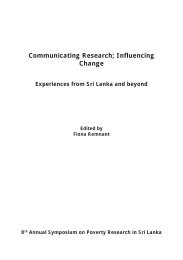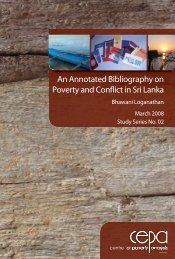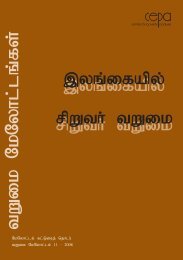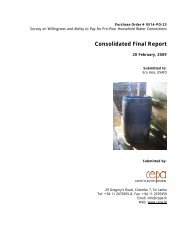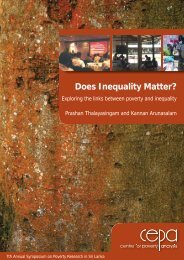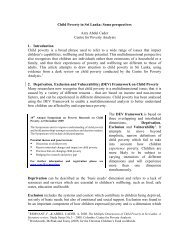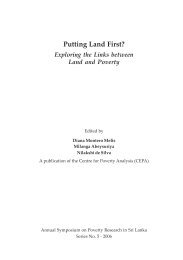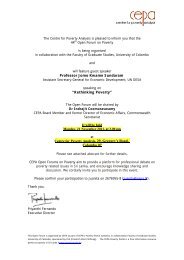Involuntary Displacement and Resettlement â Policy and ... - CEPA
Involuntary Displacement and Resettlement â Policy and ... - CEPA
Involuntary Displacement and Resettlement â Policy and ... - CEPA
- No tags were found...
Create successful ePaper yourself
Turn your PDF publications into a flip-book with our unique Google optimized e-Paper software.
The Western Province assessment found that slightly over 50% of the 1,323families living in transitional shelter sites in the Colombo district had notreceived any permanent housing assistance (Table 2 below), whichprompted an additional study to better underst<strong>and</strong> the circumstances ofthese families.Table 2: <strong>Resettlement</strong> options for families in shelter sites in Colombo –May 2007ABCDFamilies who were notified of receiving apermanent house (donor driven)Families who received a l<strong>and</strong> grant for Rs.250,000 (self-settlement)Families who received the grant <strong>and</strong>bought the l<strong>and</strong> (as a % of B)Families who received neither (noresettlement assistance)# %160 12447 34418 93.5716 54Tsunami reconstruction followed a ‘house-to-house’ rule meaning that if onecould prove owning a house at the time of the tsunami, then that housewould be replaced. Table 2 shows the post-tsunami housing replacementmodalities. The first modality is donor-driven housing (A). Under thisscheme, the government h<strong>and</strong>ed over a block of l<strong>and</strong> to a donor that usuallyhired a contractor to build rows of identical houses that were ‘h<strong>and</strong>ed over’to beneficiaries. The donor is responsible for constructing internal roads,providing water, sanitation <strong>and</strong> electricity <strong>and</strong> often a community centre or aplayground. The second modality is known as ‘owner-driven’ housing <strong>and</strong>has two sub-divisions. The first type of owner driven housing is the receiptof a cash grant from the government of Rs. 250,000 to rebuild one’s housewhere the house was st<strong>and</strong>ing at the time of the tsunami (no relocationinvolved – not shown in Table 2). The second type of owner-driven housingwas the receipt of a cash grant of Rs. 250,000 to buy a piece of l<strong>and</strong> forrelocation <strong>and</strong> then a second cash grant of Rs. 250,000 to build a house onthat newly-purchased piece of l<strong>and</strong> (B, which I refer to as ‘self-settlement’).The high number of families (54%) in Colombo shelter sites that claimedthat they had yet to receive any housing resettlement assistance (D)prompted the follow-up study that is the subject of this section 9 .9The study, funded by UNICEF, was undertaken by UNOPS on behalf of the Center on HousingRights <strong>and</strong> Eviction (COHRE). The interview format included 97 questions that correspondedwith the various property rights regimes <strong>and</strong> l<strong>and</strong> tenure arrangements that would have beenpossible at the time of the tsunami as well as questions about the family’s current location in thecompensation/resettlement process.184



